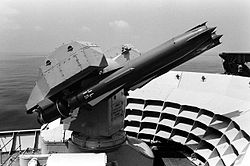Sea darts
| Sea darts | |
|---|---|
| General Information | |
| Type | Anti-aircraft missile |
| Local name | GWS30 |
| NATO designation | Sea darts |
| Country of origin |
|
| Manufacturer | British Aerospace |
| development | 1963 |
| Commissioning | 1973 |
| Working time | in service |
| Technical specifications | |
| length | 4.35 m |
| diameter | 420 mm |
| Combat weight | 544 kg |
| span | 920 mm |
| Drive First stage Second stage |
Solid fuel booster Bristol Siddeley Odin Ramjet |
| speed | Mach 3.5 (1,175 m / s) |
| Range | 74 km |
| Service ceiling | 25,000 m |
| Furnishing | |
| steering | Inertial navigation platform |
| Target location | SARH |
| Warhead | 26 kg fragmentation warhead |
| Detonator | Proximity and impact fuses |
| Weapon platforms | Ships |
| Lists on the subject | |
The Sea Dart is an anti-aircraft missile used by the British Royal Navy . It was replaced by the PAAMS Aster from 2009 .
history
The Sea Dart was developed by British Aerospace in the 1960s . In 1973 it was first installed on the guided missile destroyer HMS Bristol and subjected to extensive tests. From 1975 the anti- aircraft destroyers of the Sheffield class and from 1977 the aircraft carriers of the Invincible class were equipped with the Sea Dart. HMS Bristol used the system until it was converted into a training ship in 1993. On the Invincible-class aircraft carriers, the Sea Dart was removed between 1998 and 2000 as the flight deck was enlarged. The last Sea Dart systems will leave the fleet with the Sheffield class destroyers from 2007. The next generation of destroyers, the Daring- class , was equipped with the more modern Aster missiles .
commitment

The Sea Dart was first used during the Falklands War in 1982. A total of three Argentine aircraft were shot down, plus the accidental shooting down of a British Gazelle helicopter. The weaknesses of the system became apparent, however, in the case of missiles that approached the ships in high-speed low-level flight or over land. This resulted in a total of six ships, including two Sheffield-class destroyers, being hit by Argentine missiles. As a result of this experience, the Type 965 radar from the 1950s that had previously been used for target acquisition was replaced by the more modern Type 1022 radar.
During the Second Gulf War in February 1991, a Sea Dart was the first and to date only successful launch of a rocket by a sea-based anti-aircraft missile in an emergency. The guided missile destroyer HMS Gloucester successfully used the Sea Dart against an approaching Iraqi Silkworm missile after attempts by the US frigate USS Jarrett (FFG-33) to intercept the missile failed.
